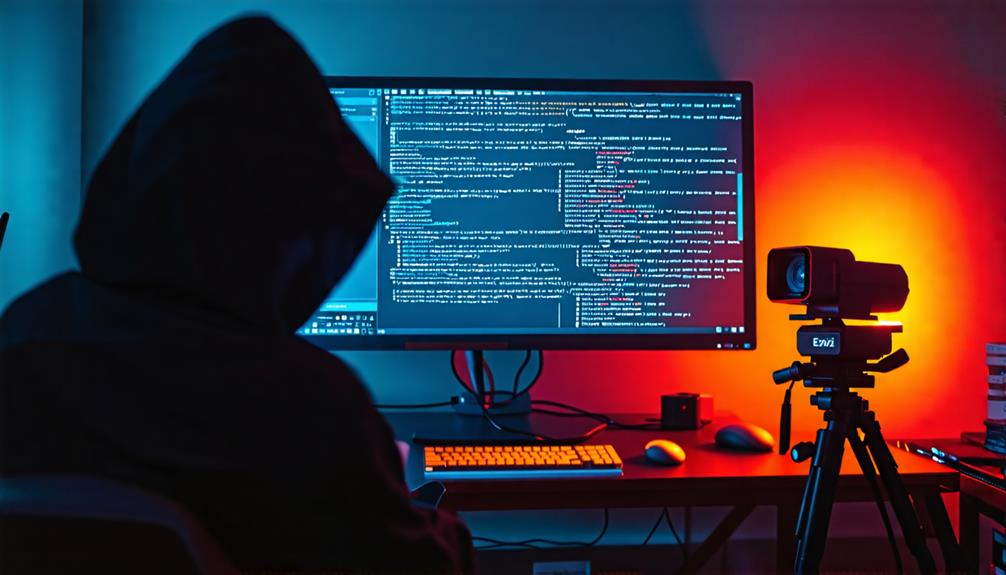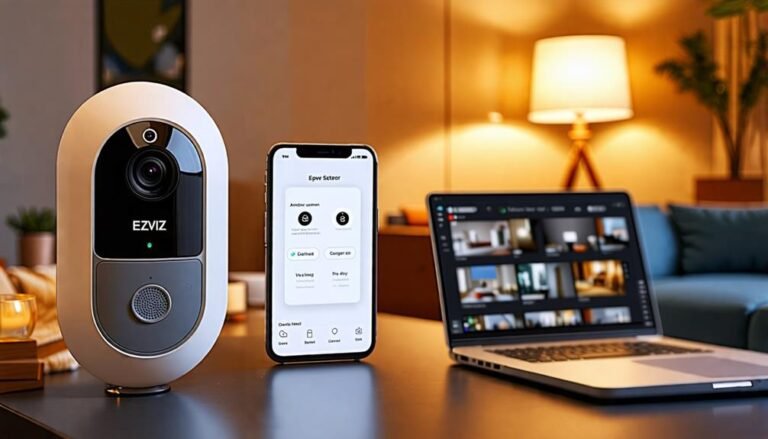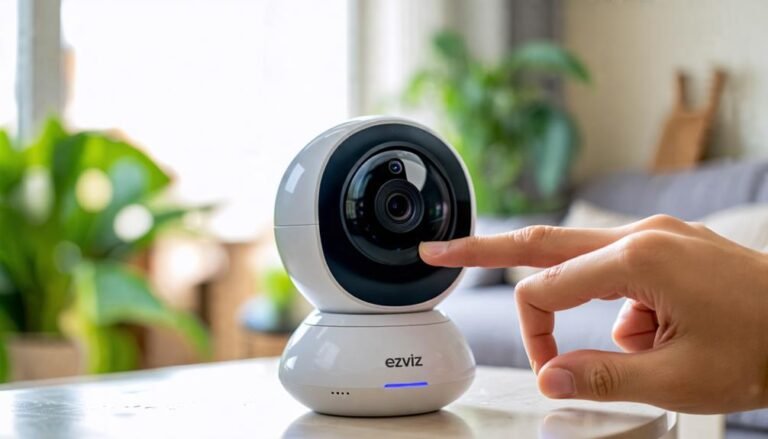Yes, Ezviz cameras can be hacked, especially if you don't take proper security measures. Default passwords and unsecured networks make it easy for hackers to gain access. Many users forget to change their default credentials, increasing vulnerability. Outdated firmware can also leave your camera exposed to known threats. Bad actors often use phishing, brute force attacks, or manipulate unsecured networks to breach security. To protect yourself, it is crucial to use strong passwords and keep your firmware updated. Want to sharpen your security knowledge further? There's more valuable information to help you safeguard your devices effectively.
Overview of Ezviz Cameras
Ezviz cameras offer a reliable solution for home and business security, making them a popular choice among consumers. These cameras blend advanced technology with user-friendly features, allowing you to monitor your space with ease. Whether you're at home or away, you can keep an eye on things in real-time, empowering you to feel secure and in control of your environment.
One standout feature is their high-definition video quality. You won't have to squint at grainy footage; instead, you'll enjoy crystal-clear images that capture every detail. Plus, many models come with night vision capabilities, ensuring your property remains protected even after the sun goes down.
Ezviz cameras also offer flexible installation options. Whether you prefer a wired setup or the convenience of wireless, you can choose what works best for you. Their mobile app is another highlight, allowing you to access live feeds, receive alerts, and review recordings from the palm of your hand. You'll have the freedom to manage your security on your terms, no matter where you are.
Moreover, with features like two-way audio, you can communicate directly through the camera, adding an extra layer of interaction and deterrence. You're not just watching; you're engaging. Ultimately, Ezviz cameras provide an accessible solution for anyone looking to enhance their security without compromising their freedom. With these cameras, you can take charge of your safety and enjoy peace of mind.
Common Security Vulnerabilities
When using Ezviz cameras, you'll want to be aware of common security vulnerabilities that can put your privacy at risk. Many users overlook the dangers of default passwords and weak security settings, which can make it easy for intruders to gain access. Additionally, unsecured network connections can expose your camera feeds to potential hacking attempts, so it's essential to take preventative measures.
Default Passwords and Weaknesses
Many users overlook the importance of changing default passwords on their security cameras, leaving them vulnerable to cyberattacks. When you buy an Ezviz camera, it often comes with a factory-set password that's easy for hackers to guess. If you want to maintain your freedom and privacy, it's essential to take this simple step.
Here's a quick look at the risks associated with default passwords:
| Risk | Description |
|---|---|
| Easy Access | Default passwords are widely known or easily guessed. |
| Lack of Accountability | If unauthorized users access your camera, it's hard to trace who did it. |
| Compromised Privacy | Hackers can view your live feed or recorded footage. |
Unsecured Network Connections
Leaving default passwords unchanged isn't the only vulnerability to be aware of; unsecured network connections pose a significant risk as well. If your Ezviz camera connects to an open or poorly secured Wi-Fi network, you're fundamentally rolling out the welcome mat for hackers. They can easily intercept the data being transmitted, giving them access to your camera feeds and personal information.
Imagine you're streaming footage of your home or family, but anyone within range of that unsecured network could potentially watch it too. To truly protect your freedom and privacy, it's vital to secure your Wi-Fi. Always use strong, unique passwords for your network, and enable encryption protocols like WPA3.
Additionally, keep your firmware updated; manufacturers often release patches to address security vulnerabilities. If you can, consider using a Virtual Private Network (VPN) to add an extra layer of protection. You want peace of mind knowing your security systems are truly secure. Remember, an unsecured connection can easily turn your privacy into public knowledge, so take the necessary precautions to safeguard your freedom and security.
Methods Used by Hackers
When it comes to hacking Ezviz cameras, attackers often rely on common techniques that exploit vulnerabilities. They might target outdated firmware to gain unauthorized access, making your security system more susceptible to breaches. Understanding these methods is essential for protecting your devices effectively.
Common Hacking Techniques
In the world of cybersecurity, hackers employ a variety of common techniques to breach systems and gain unauthorized access to sensitive information. One popular method is phishing, where attackers trick you into revealing personal information by masquerading as legitimate entities. You might receive an email that appears to be from your bank, prompting you to click a link and enter your credentials, unknowingly giving hackers the keys to your digital life.
Another technique is brute force attacks, where hackers use automated tools to guess your passwords. If your password's weak or easily guessable, they can crack it in no time. It's essential to use complex passwords and enable two-factor authentication whenever possible to enhance your security.
Additionally, many hackers exploit unsecured networks. If you connect to public Wi-Fi without a VPN, you're opening the door to potential threats. Always be cautious about the networks you join.
Vulnerabilities in Firmware
Firmware vulnerabilities are often a prime target for hackers seeking to exploit security weaknesses in devices like Ezviz cameras. These vulnerabilities can give unauthorized users access to your camera feeds, compromising your privacy and safety. Understanding how hackers exploit these weaknesses can help you protect your devices.
Here are some common methods they use:
- Default Credentials: Many people forget to change the default usernames and passwords, making it easy for hackers to gain access.
- Outdated Firmware: Failing to update your camera's firmware can leave it open to known exploits.
- Unsecured Networks: Using weak or unsecured Wi-Fi can allow hackers to intercept data and access your devices.
- Malware Injections: Hackers may inject malicious code into your firmware, enabling them to control your camera remotely.
- Social Engineering: Manipulating users into revealing sensitive information or granting access is a tactic often used by hackers.
Staying vigilant about these vulnerabilities is essential. Regular updates, strong passwords, and secure networks can go a long way in keeping your Ezviz cameras—and your privacy—safe from prying eyes.
Real-Life Hacking Incidents
Numerous real-life hacking incidents have highlighted the vulnerabilities in home security systems, including popular brands like Ezviz. You might think your home is secure, but hackers often exploit weak points, leaving your privacy at risk. These breaches can be alarming, especially when you realize that seemingly innocuous devices can be entry points for cyber intrusions.
Take a look at some recent incidents:
| Incident | Date | Outcome |
|---|---|---|
| Smart home hack | Jan 2022 | Unauthorized access to camera feeds |
| Webcam breach | Mar 2021 | Personal video streams leaked to the internet |
| IoT device exploit | Aug 2020 | Home network compromised, leading to data theft |
In these cases, hackers gained access to cameras and other smart devices, often using default passwords or outdated firmware. It's crucial to recognize that even well-known brands can fall victim to exploitation. You might think you're safe behind a camera, but if it's not properly secured, you're opening a door for potential threats.
To truly safeguard your home, consider changing default settings, regularly updating software, and using strong, unique passwords. Awareness is your first line of defense. Don't let your desire for modern conveniences compromise your freedom and security. Instead, take proactive steps to guarantee your home remains a safe haven, rather than a target for those looking to invade your privacy.
Risks of Hacking Surveillance
Many homeowners underestimate the risks associated with hacking surveillance systems like Ezviz cameras. You might think that having these cameras in place offers a solid layer of security, but the truth is, they can become a double-edged sword if they fall into the wrong hands. When hackers infiltrate your surveillance system, the consequences can be severe, putting your privacy and safety at risk.
Consider these potential dangers:
- Unauthorized Access: Hackers can view your live feeds and recorded footage, invading your privacy.
- Data Theft: Personal information stored in your system could be stolen and misused.
- Manipulation of Footage: Intruders could alter or delete footage, eliminating evidence of criminal activity.
- Disabling Security Features: Hackers can disable your cameras, leaving you unprotected during a break-in.
- Targeting Other Devices: Once in your system, they may gain access to other connected devices in your home.
The reality is that a compromised surveillance system can lead to a loss of freedom and security. You might find it hard to feel safe in your own home, knowing that someone could be watching you or worse, planning a way to exploit your vulnerabilities. It's vital to remain aware of these risks and take them seriously. The freedom you desire hinges on your ability to protect your personal space. Stay vigilant and informed—your security depends on it.
Enhancing Camera Security
To combat the risks associated with hacking surveillance systems, enhancing the security of your Ezviz cameras is paramount. You want to guarantee your privacy and peace of mind while enjoying the freedom that comes with modern technology. Start with a strong password; avoid using default settings that hackers often exploit. Create a unique combination of letters, numbers, and symbols. The stronger the password, the harder it is for unauthorized users to gain access.
Next, regularly update your camera's firmware. Manufacturers frequently release updates to patch vulnerabilities. Ignoring these updates can leave your system exposed, so make it a habit to check for them. Additionally, consider enabling two-factor authentication (2FA) if available. This extra layer of security requires a second verification step, making it notably harder for hackers to break in.
Be mindful of your home network as well. Use a secure Wi-Fi connection with WPA3 encryption, and avoid easily guessed network names. You might also want to set up a separate network for your cameras, isolating them from your primary devices. This separation adds another layer of protection.
Lastly, regularly review your camera settings and access logs. Being proactive about monitoring who has access to your cameras can help you catch any suspicious activity early. By taking these steps, you can notably enhance the security of your Ezviz cameras and enjoy the freedom of surveillance without the looming threat of hacking. Remember, your safety is worth the effort.
Best Practices for Users
When setting up your Ezviz cameras, a few best practices can make a significant difference in their effectiveness and security. You want to guarantee your devices are not just functional but also protected from potential threats. Here's what you can do to boost your camera's security:
- Change default passwords: Don't stick with the factory settings. Create a strong, unique password that's hard to guess.
- Enable two-factor authentication: This adds an extra layer of security by requiring a second form of verification when logging in.
- Keep firmware updated: Regularly check for and install updates to guarantee your camera has the latest security features.
- Limit access: Only give access to trusted individuals and maintain control over who can view your camera feeds.
- Use secure networks: Avoid public Wi-Fi for your camera's connection. Stick to a secure, private network to minimize risks.
Future of Smart Camera Security
As technology advances, the future of smart camera security looks promising yet complex. You're entering a domain where cameras not only watch over your home but also integrate with other smart devices, creating a network of security that's both convenient and effective. However, with this convenience comes the need for vigilance. You can't ignore the fact that as cameras get smarter, so do the threats against them.
Imagine a world where your security system learns your habits and alerts you only when it detects unusual activity. This is the future we're heading toward, where artificial intelligence plays a vital role in distinguishing between everyday occurrences and potential threats. You'll find yourself empowered, able to monitor your property from anywhere, using your smartphone to check in whenever you want.
Yet, it's important to remain aware. The freedom that smart cameras offer can also lead to vulnerabilities. Cybersecurity will need to evolve in tandem with technology. You'll have to stay informed about the latest security measures, ensuring your devices are updated and your data encrypted.
In this landscape, privacy and security aren't just features; they're fundamental rights. As you embrace smart camera technology, remember that your choices matter. Balancing convenience with security is key, and by staying proactive, you can enjoy the freedom that comes with modern technology, while keeping your home safe from prying eyes—both digital and physical.
Frequently Asked Questions
Are Ezviz Cameras Safe for Outdoor Use?
Imagine you're a knight guarding your castle, and your watchtower is equipped with Ezviz cameras. They're designed for outdoor use, protecting your territory from intruders. With weather resistance and high-definition capabilities, they help keep your surroundings secure. However, just like any guardian, it's wise to guarantee their defenses are updated. By taking the right precautions, you can enjoy the freedom of safety, knowing your castle is well-monitored and your treasures are secure.
Can I Reset My Ezviz Camera After a Hack?
Yes, you can reset your Ezviz camera if you suspect it's been compromised. To do this, locate the reset button on the device, usually found at the back or bottom. Press and hold it for about 10 seconds until you see the LED indicator blink. This'll restore factory settings, allowing you to set it up again. After resetting, make sure to update your firmware and use strong passwords for better security.
What Encryption Methods Do Ezviz Cameras Use?
Ezviz cameras typically use a combination of encryption methods to secure your data, including AES (Advanced Encryption Standard) and SSL (Secure Sockets Layer) protocols. These methods help guarantee that your video feeds are protected from unauthorized access. While no system is entirely foolproof, these encryption techniques greatly enhance your privacy and security. It's crucial to stay updated on firmware and security practices to maintain the integrity of your surveillance setup.
Do Ezviz Cameras Work Without Internet Access?
Did you know that around 30% of security camera users prefer standalone systems for privacy? Ezviz cameras can work without internet access, allowing you to maintain control over your footage. Without the internet, they can still record locally onto a microSD card. However, you won't have remote access or real-time alerts. This setup gives you the freedom to monitor your surroundings without relying on external networks, enhancing your privacy and security.
How Can I Report a Hacked Ezviz Camera?
If you suspect your Ezviz camera's been hacked, you should act quickly. Start by changing your camera's password and updating the firmware. Then, contact Ezviz customer support for assistance; they'll guide you on securing your device. It's also wise to report the incident to local authorities, especially if you notice any suspicious activity. Finally, consider reviewing your home network's security settings to prevent future breaches. Stay vigilant!



